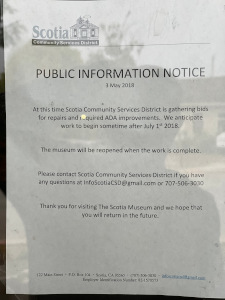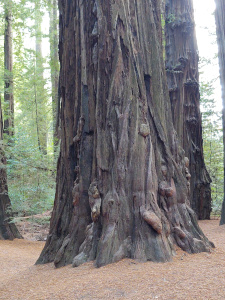This morning was warmer than the previous two days. We seem to be adjusting to the weather along the ocean. We headed for Fort Bragg on the Mendocino coast  2018 Public notice, Scotia museum
by way of the Avenue of the Giants, which took us again into the redwood forests. This road runs parallel to the bustling highway 101 but the highway noise was only occasionally heard, because the forest is thick and the sights along the scenic drive take our full attention.
2018 Public notice, Scotia museum
by way of the Avenue of the Giants, which took us again into the redwood forests. This road runs parallel to the bustling highway 101 but the highway noise was only occasionally heard, because the forest is thick and the sights along the scenic drive take our full attention.
Not far from Fortuna, we stopped at Scotia, a company town, presumably erected by a lumber company, sometime in the late nineteenth century. We saw a half dozen long streets lined with identical small houses, vivid example of the paternalistic practices of large corporations of that time. At the entrance to the town we stopped to gaze at the town museum, a beautiful (though shabby) wooden building built on the idea of a Greek temple; the redwood pillars had been carved to resemble the marble columns of a Greek building. A sign on the door read that the museum would be closed until repairs and restoration work could be begun to make the building safe for visitors; permits were expected shortly. The note was dated in 2018.
 Neck exercise to locate the treetops
Neck exercise to locate the treetops
There was other industry in town. An enormous complex of wooden buildings was labelled Water Storage. We later learned that the bundles ready for shipment are large plastic water containers. We know Mendocino is having critical water shortages; apparently individual citizens can purchase their own water-storage tanks. The bulk of the property was occupied by a sawmill and its components, such as piles of sawdust and stacks of logs.
Just a few miles south we found the northern entrance to the Avenue of the Redwoods. We followed it for 31 miles which took us almost three hours through beautiful scenery, and very light traffic. The forest was as thick as we had seen it farther North and the  Lumpy growths near base of redwood
undergrowth, again mostly ferns and assorted shrubs, provided a carpet which seemed a foot or more high in places.
Lumpy growths near base of redwood
undergrowth, again mostly ferns and assorted shrubs, provided a carpet which seemed a foot or more high in places.
Every few miles we would find a marker to read. Often it marked the donor of money for a grove. One such was John D. Rockefeller, who was so thrilled by his first sight of redwoods in the 1920s that he donated one million dollars for a grove in his name, and later gave another million to save another patch. Another marked activists, Laura and John Mahan, "who were instrumental in preserving the forest.In response to attempted logging in 1924, Laura protested by physically putting herself between the trees and equipment while James took to the courts to have the logging stopped. Logging was delayed in time for Save the Redwoods League to purchase and preserve this beautiful grove."
Other markers identify groups like the California Federation of Women's Clubs, the Boy Scouts, and local civic groups.
We stopped to take a brief stroll in Bolling  1964 Eel River flood marker
grove; the name struck a chord in Bob's memory. In February of 1959, just assigned to duty as a newly-commissioned ensign in the Coast Guard Reserve, he was assigned a billet at Anacostia Naval Air Station, just next to Bolling Air Force Base, which had a better exchange (Air Force bases always did!). It was the same man: Colonel Raynal Bolling was honored as the first senior officer to die in WW I (he was Assistant Chief of the Air Service). These days the two have been combined into Joint Base Anacostia-Bolling. Here the name represented a grove of giant coast redwoods.
1964 Eel River flood marker
grove; the name struck a chord in Bob's memory. In February of 1959, just assigned to duty as a newly-commissioned ensign in the Coast Guard Reserve, he was assigned a billet at Anacostia Naval Air Station, just next to Bolling Air Force Base, which had a better exchange (Air Force bases always did!). It was the same man: Colonel Raynal Bolling was honored as the first senior officer to die in WW I (he was Assistant Chief of the Air Service). These days the two have been combined into Joint Base Anacostia-Bolling. Here the name represented a grove of giant coast redwoods.
Our road followed the Eel River which today was mostly gravel with patches of water here and there. At one point, Weott, we saw a marker posted atop a 35-foot pole which indicates the high-water level during the flood of 1964. The total rise of the flood was over 90 feet higher than "normal."
We left the Avenue nearly at the point where we moved from Humboldt County into Mendocino County and left the forest to follow the ocean shore. That was a thrilling ride at the northern beginning of California's famed Highway 1, but we have plenty of experience driving on narrow, twisty, hilly roads across mountains.
When we reached the ocean we stopped at an overlook and took a picture of cormorants on a guano-covered rock just offshore.
Another military officer was honored in the naming of Fort Bragg, California, founded in 1857:  Cormorants on rock
Braxton Bragg had fought in the Seminole Wars and the Mexican War and retired near Thibodeaux, Louisiana, where he bought a sugar plantation. His army career was colored by a court martial for anonymously publishing a paper excoriating Gen. Winfield Scott. But after decorations for heroism in the Mexican War, he was promoted and then he retired from the U.S. Army in 1856. Then he joined the Confederate Army, where he became one of the South's most unpopular and unsuccessful generals, being recalled from the field to serve as an advisor to Jefferson Davis.
Cormorants on rock
Braxton Bragg had fought in the Seminole Wars and the Mexican War and retired near Thibodeaux, Louisiana, where he bought a sugar plantation. His army career was colored by a court martial for anonymously publishing a paper excoriating Gen. Winfield Scott. But after decorations for heroism in the Mexican War, he was promoted and then he retired from the U.S. Army in 1856. Then he joined the Confederate Army, where he became one of the South's most unpopular and unsuccessful generals, being recalled from the field to serve as an advisor to Jefferson Davis.
Fort Bragg was busy on this Saturday with tourists and townsfolk, startling after a morning in the woods. We were surprised to learn that it was after noon when we found lunch. We stocked up on tourist maps and advice at the local visitor center, checked into our hotel, and started learning about what we will find tomorrow in Fort Bragg, and then afterwards in more familiar territory in Sonoma County.
 2018 Public notice, Scotia museum
by way of the Avenue of the Giants, which took us again into the redwood forests. This road runs parallel to the bustling highway 101 but the highway noise was only occasionally heard, because the forest is thick and the sights along the scenic drive take our full attention.
2018 Public notice, Scotia museum
by way of the Avenue of the Giants, which took us again into the redwood forests. This road runs parallel to the bustling highway 101 but the highway noise was only occasionally heard, because the forest is thick and the sights along the scenic drive take our full attention.
 Neck exercise to locate the treetops
Neck exercise to locate the treetops Lumpy growths near base of redwood
Lumpy growths near base of redwood 1964 Eel River flood marker
1964 Eel River flood marker Cormorants on rock
Cormorants on rock